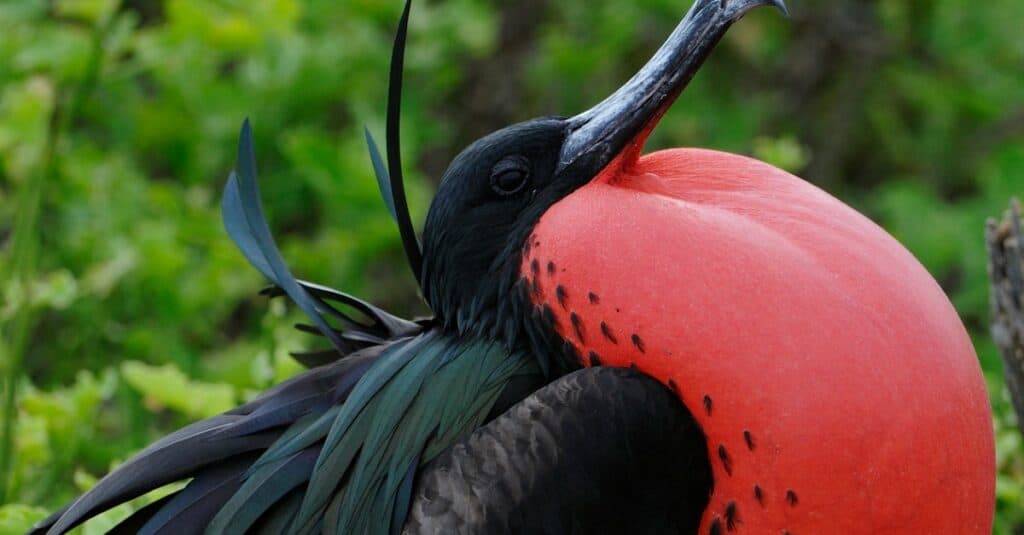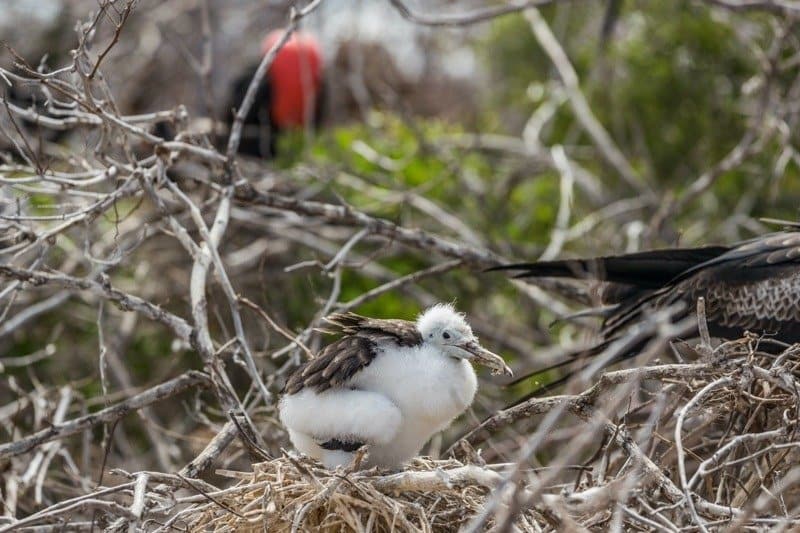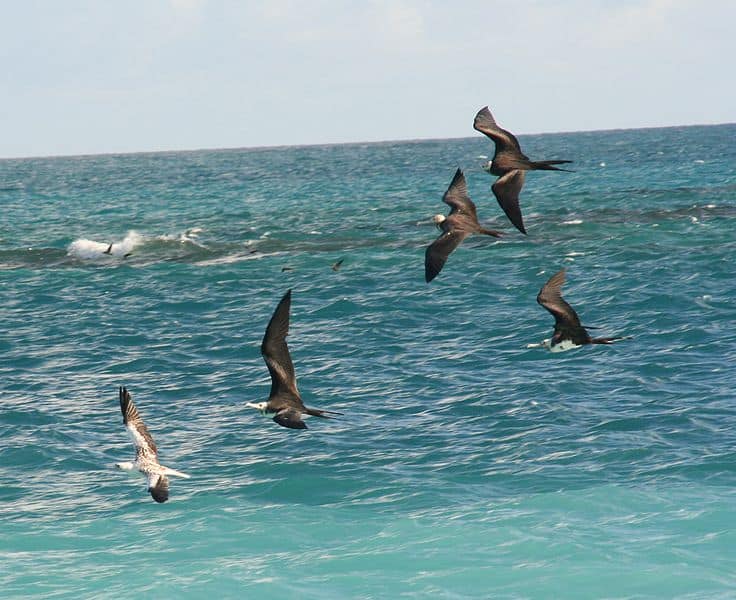Frigatebird facts are multiple and marvelous. For instance, these birds, also known as fregeta, are a species of subtropical birds that are not only interesting to look at but also live exciting lives. Frigatebirds are known for the tropical regions they inhabit, also residing in areas where they can be close to the ocean. Let’s examine ten other interesting frigatebird facts.
1. Christmas Frigatebirds Are Becoming Extinct

Less than 7,000 Christmas Island frigatebirds remain on the island.
©iStock.com/Clay Clark
If not removed from their habitat, Christmas Island and Ascension Island frigatebirds will continue to decline in numbers. Scientists reported that less than 7,000 Christmas Island frigatebirds remain on the island. Human disturbance and weather conditions are the main reasons for their declining numbers. Additionally, the food supply for these Christmas Island frigatebirds is also running low due to increased fishing along the coasts of these two islands.
2. Frigatebird Mating Ritual Facts
The male frigatebird inflates the red sac below his beak, known as the gular pouch while nesting on land. The males gather together on the ground and perform their mating ritual, hoping to attract females soaring overheard. The male frigatebird spreads his wings, quivering his body while calling out, expecting to attract a female. Suppose a female approves of his mating call. In that case, they will gather twigs and branches and continue to build a nest in a select location. Courtship can take up to six months, with mating seasons lasting up to two years.
3. Frigatebird Fact: They’re Into Monogamy

Frigatebirds are monogamous when raising their chick.
©Maridav/Shutterstock.com
Frigatebirds remain in a monogamous pairing for an entire mating season. Mature males can breed every mating season, while females breed every other year. The female can only lay a single egg at a time and only produces one egg once every two years. The male frigatebird remains with his partner and the chick for up to three months after the egg hatches. Both the male and female then feed the chick until the male leaves.
4. Excellent Flying Abilities: A Fun Christmas Frigatebird Fact
Studies show that Christmas frigatebirds can remain flying for up to six weeks. These magnificent birds can reach high altitudes while remaining airborne without flapping their wings. Another fantastic Christmas frigatebird fact is that these birds do not suffer organ damage because of flying long distances. Instead, up to 50% of their metabolism preserves circulation and keeps their brain and lungs at total capacity. Besides, their massive wings contribute to their ability to glide across high altitudes, reaching up to 13,000 feet for lengthy periods.
5. They Can’t Survive on the Ocean Surface
Frigatebirds are tropical birds, but their feathers are not waterproof. They are also not fishing birds because they are prone to drowning. Unlike seagulls that can rest on the ocean surface and dive to hunt for prey, frigatebirds can only stay in shallow water pools closer to rocks and land. They cannot swim and prefer to cool down or enjoy the water in shallow rock pools or streams. Frigatebirds spend most of their lives flying but live in large colonies on islands along the Pacific ocean. Smaller frigatebird colonies have been discovered along the beach near the Indian and Atlantic oceans but remain limited in their numbers.
6. Females Spend a Long Time With Their Young

Frigatebird hatchlings can take six months to learn how to fly, remaining dependent on their mother.
©Duncan Wright – Public Domain
Female frigatebirds spend up to 18 months with their chicks. The egg takes up to two months to hatch, with adult females feeding their chick an additional six months. Besides, the hatchling can take six months to learn how to fly, remaining dependent on its mother. Even when they can hunt for themselves, fledglings stay by their mother’s side for a year before gaining independence.
7. Different Identities – An Intriguing Frigatebird Fact
Male frigatebirds showcase a red gular pouch while the females have a white chest. They are the only birds in the tropical bird species with distinct differences between males and females that you can readily spot. Males also have a green and purple sheen on their upper plumage.
8. They Cannot Survive Around Humans

Frigatebirds take flight and, as part of their survival mode, steal from other fledglings and small birds.
©iStock.com/ksumano
Frigatebirds live in large colonies away from humans. They are vulnerable on the ground, and coming in close contact with humans only activates their predatory nature. They take flight and, as part of their survival mode, steal from other fledglings and small birds. To protect themselves and assert dominance in the sky, they can easily harass other birds for their nesting materials and food until they settle on land again.
9. Pirates of the Skies – A Curious Frigatebird Fact
They are carnivorous and feed themselves by catching tiny turtles, small fish caught in low rock pools, or stealing from other birds. They harass other birds until they spit out their food and even hunt unattended nests, eating the young of their competitors. These birds use their sharp beaks to harass other birds in the sky. They pull at their wings or poke their bodies until they fly closer to the ground to drop their food or regurgitate it. Once that happens, it is easy for the frigatebird to retrieve the morsel quickly. Red-footed boobies and brown boobies fall prey to frigatebird attacks. They force these birds to crash land if they refuse to give up their catch or feed on them if they are small enough.
10. Bodies Built for Flying

Frigatebirds sleep while flying and can even catch and consume their prey in the same flight.
©Duncan Wright – Public Domain
Scientists have recorded frigatebirds flying at heights of up to 2,500 meters or 1.55 miles, making them the highest flying of all the bird species. Their giant wings and low muscle mass allow them to glide in the sky for long periods without tiring. This ability is partly attributable to the frigatebirds’ small bodies compared to their wingspans, making them very light. They settle in the evening for roosting when they aren’t in the skies for weeks. Also, they sleep while flying and can even catch and consume their prey in the same flight. Moreover, their flight response is better in vertical winds, and they use the winds to locate vulnerable targets.
Up Next – Christmas Frigatebird Facts and Other Feathered Friend News
- Frigatebird
- 10 Incredible Albatross Facts
- Mississippi’s 5 Best Bird Watching Spots This Summer
- Are Birds Mammals?
- The 8 Weirdest Birds in the World
The photo featured at the top of this post is © Aviceda at en.wikipedia / Creative Commons / Original
Sources
- Nature Communications (2016) www.nature.com/articles/ncomms12468
- Cook Islands Biodiversity (2003) data.bishopmuseum.org/pbs/cookislands/
- JSTOR Daily, Available here: https://daily.jstor.org/the-astounding-adaptations-of-long-distance-flyers/
Thank you for reading! Have some feedback for us? Contact the AZ Animals editorial team.






